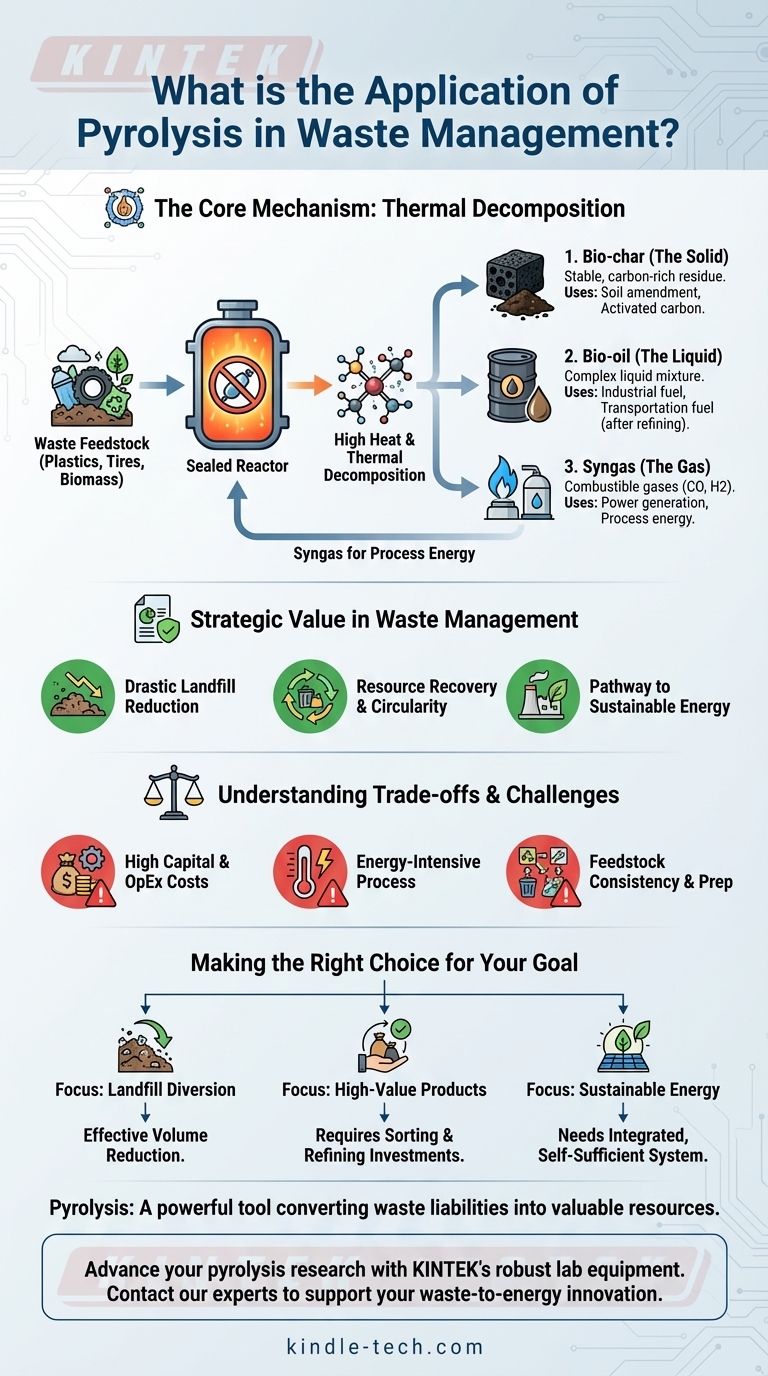At its core, pyrolysis is a thermal decomposition process used in waste management to convert solid waste into valuable resources. By heating materials like plastics, tires, or biomass in an oxygen-free environment, it breaks them down into a solid residue (bio-char), a liquid (bio-oil), and a combustible gas (syngas) instead of simply burning them.
Pyrolysis presents a powerful alternative to traditional landfilling by transforming waste into usable energy and materials. However, its practical application is a balancing act between its high potential for resource recovery and its significant capital costs and operational complexity.

How Pyrolysis Transforms Waste
To understand its application, you must first understand the fundamental mechanism. Pyrolysis is not incineration; the absence of oxygen is the critical factor that prevents combustion and instead triggers a chemical transformation.
The Core Mechanism: Thermal Decomposition
The process involves sealing waste inside a reactor and heating it to high temperatures. This intense heat breaks the complex chemical bonds within the waste materials, decomposing them into simpler, more stable components.
Because there is no oxygen, the materials do not burn. Instead, they vaporize and break apart, and the resulting products are then collected as they cool.
The Three Key Outputs
The process consistently yields three primary products, each with its own downstream applications. The ratio and quality of these outputs depend heavily on the type of waste feedstock and the specific pyrolysis conditions (e.g., temperature and heating rate).
Bio-char (The Solid)
Bio-char is the stable, carbon-rich solid residue left behind. It can be used as a soil amendment to improve soil fertility and water retention or processed further to create activated carbon for filtration and purification purposes.
Bio-oil (The Liquid)
Also known as pyrolysis oil, this is a complex liquid mixture. While it requires refining, it can be upgraded into transportation fuels or used directly as an industrial fuel for boilers or furnaces to generate power.
Syngas (The Gas)
Syngas is a mixture of combustible gases, primarily carbon monoxide and hydrogen. It has a significant energy value and is often used to power the pyrolysis process itself, making the system more energy-efficient. Excess syngas can also be used to generate electricity.
The Strategic Value in Waste Management
Pyrolysis moves beyond simple disposal and positions waste as a valuable feedstock for a circular economy. Its primary value lies in its ability to reduce environmental burdens while creating new resources.
Drastic Landfill Volume Reduction
The most immediate benefit of pyrolysis is its ability to divert large volumes of waste from landfills. This not only saves precious landfill space but also mitigates the long-term environmental risks associated with them, such as methane emissions and leachate contamination.
Resource Recovery and Circularity
Instead of burying or burning materials, pyrolysis embodies the principles of a circular economy. It unlocks the chemical energy and raw material value stored in waste, turning a liability into an asset.
A Pathway to Sustainable Energy
By converting non-recyclable waste into fuels and electricity, pyrolysis provides a source of localized, sustainable energy. This reduces reliance on fossil fuels and can create a more resilient energy infrastructure.
Understanding the Trade-offs and Challenges
While promising, pyrolysis is not a silver bullet. A clear-eyed assessment of its limitations is crucial for successful implementation.
High Capital and Operational Costs
Pyrolysis facilities require a significant upfront investment in reactors, material handling systems, and product purification equipment. The operational costs, particularly the energy required to run the process, must also be carefully managed.
The Process is Energy-Intensive
Reaching the high temperatures necessary for pyrolysis demands a substantial energy input. For a facility to be economically and environmentally sound, the energy generated from the syngas must ideally offset this consumption.
Feedstock Consistency is Key
The efficiency and output of a pyrolysis system are highly sensitive to the type and quality of the waste feedstock. Mixed, contaminated, or inconsistent waste streams can reduce yields and produce lower-quality end products, making pre-sorting and preparation essential.
Product Separation and Upgrading
The raw bio-oil and syngas are not immediately ready for high-value use. They require cleaning, separation, and often further chemical upgrading to meet commercial fuel standards, which adds another layer of technical complexity and cost.
Making the Right Choice for Your Goal
Whether pyrolysis is the correct solution depends entirely on your primary objective.
- If your primary focus is landfill diversion: Pyrolysis is an extremely effective technology for reducing the volume of solid waste that requires final disposal.
- If your primary focus is creating high-value products: Be prepared to invest in sophisticated feedstock sorting systems and downstream refining processes to upgrade the bio-oil and bio-char.
- If your primary focus is sustainable energy production: Success hinges on designing an integrated system where the energy from syngas makes the entire operation self-sufficient or even a net energy exporter.
Ultimately, pyrolysis is a powerful tool for resource recovery, transforming our perception of waste from a problem to be disposed of into a resource to be unlocked.
Summary Table:
| Pyrolysis Output | Primary Application |
|---|---|
| Bio-char (Solid) | Soil amendment, activated carbon for filtration |
| Bio-oil (Liquid) | Industrial fuel, upgraded to transportation fuels |
| Syngas (Gas) | Power generation, process energy |
| Key Benefit | Diverts waste from landfills, supports circular economy |
Ready to transform your waste management strategy with advanced pyrolysis solutions? KINTEK specializes in providing robust lab equipment and consumables for pyrolysis research and development. Whether you're exploring feedstock suitability, optimizing output yields, or scaling up your process, our expertise can help you achieve efficient and sustainable resource recovery. Contact our experts today to discuss how we can support your laboratory's innovation in waste-to-energy technologies!
Visual Guide

Related Products
- Electric Rotary Kiln Small Rotary Furnace Biomass Pyrolysis Plant
- Customizable High Pressure Reactors for Advanced Scientific and Industrial Applications
- Vacuum Sealed Continuous Working Rotary Tube Furnace Rotating Tube Furnace
- Chemical Vapor Deposition CVD Equipment System Chamber Slide PECVD Tube Furnace with Liquid Gasifier PECVD Machine
- Electrolytic Electrochemical Cell Gas Diffusion Liquid Flow Reaction Cell
People Also Ask
- What is the application of pyrolysis in biomass? Converting Waste into Bio-Oil, Biochar, and Renewable Energy
- What are the steps of biomass pyrolysis? Turn Waste into Biochar, Bio-Oil & Biogas
- What are the problems with biomass pyrolysis? High Costs & Technical Hurdles Explained
- What biomass is used in pyrolysis? Selecting the Optimal Feedstock for Your Goals
- What is pyrolysis technology for biomass energy? Unlock Bio-Oil, Biochar, and Syngas from Waste

















